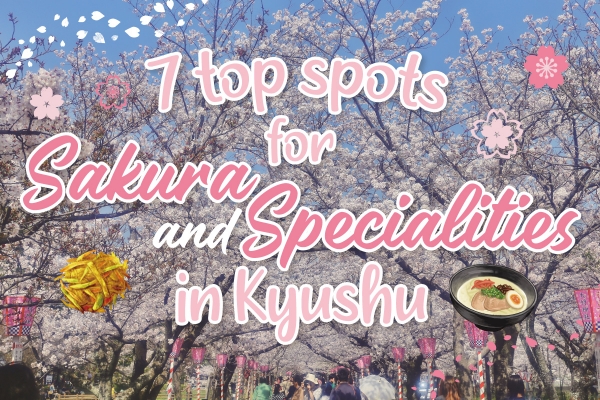7 top spots for sakura and specialities in Kyushu

Cherry blossom trees, also known as sakura (桜), are an iconic part of Japan’s landscapes and have awed visitors for centuries. In Kyushu (九州), an island known for its onsen (温泉 hot springs) and mountains, there is no shortage of places to see the sakura in their natural splendour.
If you’re fortunate enough to visit Kyushu during the sakura season (usually between March and April), here are some top spots from each prefecture to satisfy your need for sakura-viewing (and for filling your stomachs)!
Uminonakamichi Seaside Park (Fukuoka Prefecture)

This park earns its name from its location sprawled across a 6km-long sandbar, a literal “Road in the middle of the sea”. (Image credit: Kimon Berlin / CC BY-SA 2.0)
Located in Fukuoka City (福岡市 Fukuoka-shi) on a peninsula surrounded by Hakata Bay (博多湾 Hakata-wan) lies Uminonakamichi Seaside Park (海の中道海浜公園 Uminonakamichi Kaihin Kōen), a beautiful, sprawling relaxation hub consisting of several different areas including flower gardens, playgrounds, an amusement park, a water park, a zoo and large open spaces for picnicking. In addition to over 2,000 sakura trees lining its scenic trails, the park also features beautiful flower gardens with tulips, roses, hydrangeas, sunflowers and more!
Uminonakamichi Seaside Park (海の中道海浜公園)
Address: 18-25 Saitozaki, Higashi-ku, Fukuoka 811-0321
Nearest station: JR Uminonakamichi Station (海ノ中道駅)
Access: The park entrance is just a short walk from JR Uminonakamichi Station.
Opening hours: 9:30am–5pm (November–February), 9:30am–5:30pm (March–October)
Admission fee: ¥450 (Adults), Free (Ages 15 and below)
Tel: +81 92-603-1111
Must-try dish in Fukuoka Prefecture

The thickness and richness of the pork bone broth in Tonkotsu Ramen is unparalleled. (Image credit: 5amramen / Unsplash)
If there’s one food you should try while you’re in Fukuoka Prefecture (福岡県 Fukuoka-ken), it’s Hakata ramen (博多ラーメン). This hearty dish is the origin of all Tonkotsu (豚骨 pork bone broth) ramen famous across the world today, and is characterised by its cloudy and aromatic pork bone broth soup and thin, Chinese-style noodles.
Suizenji Gardens (Kumamoto Prefecture)

Even without the bloom of sakura the Suizenji Gardens are a sight to behold year-round. (Image credit: photoAC)
Located about 8km southwest of Kumamoto Castle (熊本城 Kumamoto-jō), the Suizenji Gardens (水前寺成趣園 Suizenji Jōjuen) were built in 1637 to reproduce the 53 stations of the Tokaido Road (東海道), the original route connecting Kyoto to Tokyo during the Edo Period (1603–1868). The garden landscape features a miniature Lake Biwa and Mount Fuji, and is surrounded by hundreds of sakura trees that provide a nice contrast to the garden’s other flora.
Suizenji Gardens (水前寺成趣園)
Address: 8-1 Suizenji Koen, Chuo-ku, Kumamoto, 862-0956
Nearest station: Suizenji Station (水前寺駅)
Access: The garden entrance is a 10-minute walk south from the station.
Opening hours: 8:30am–5pm (November–February), 7:30am–6pm (March–October)
Admission fee: ¥450 (Adults), ¥200 (Ages 15 and below)
Must-try dish in Kumamoto Prefecture

The garlic and black fungus add an additional layer of fragrance to the already rich tonkotsu broth. (Image credit: jpellgen / CC BY-ND 2.0)
Kumamoto ramen (熊本ラーメン) is the must-try dish in its namesake prefecture, which has a broth that combines pork bone and chicken stock, and noodles that are medium in thickness. It is topped with chashu (チャーシュー braised pork belly) and the ramen’s signature ingredients—roasted garlic chips and oil.
Omura Park (Nagasaki Prefecture)

The sea of blue, purple and pink is not to be missed. (Image credit: photoAC)
Located within the city of the same name, Omura Park (大村公園) is situated just beyond the outer walls of Kushima Castle (玖島城 Kushima-jō), and has over 2,000 sakura trees—including over 300 rare Omurazakura trees, which have two-layered flowers that can hold up to 200 petals! In addition, the park is filled with thousands of azaleas and irises, which add shades of blue and purple to the park’s landscape.
Omura Park (大村公園)
Address: 1-45-3 Kushima, Omura, Nagasaki 856-0834
Nearest station: Omura Station (大村駅)
Access: The park entrance is a 10-minute walk from the station.
Opening hours: 24 hours
Admission fee: Free
Must-try dish in Nagasaki Prefecture

A ramen dish more heavily influenced by its Chinese roots than others. (Image credit: Discover Nagasaki)
While Omura is famous for its omura-zushi (大村寿司)—a pressed, layered sushi that is served as small squares–the most iconic dish in Nagasaki Prefecture (長崎県 Nagasaki-ken) is the Nagasaki Champon (ちゃんぽん), inspired by Chinese cuisine. The thick noodles and flavourful broth made from chicken and pork bones are topped with seafood, vegetables, and lard-fried-pork to give it a rich and creamy taste.
Oka Castle Ruins (Oita Prefecture)

A former castle with a long and storied history, from feudal lords to folk song composers. (Image credit: Welcome Kyushu)
Located on the outskirts of Taketa City (竹田市 Taketa-shi), the Oka Castle Ruins (岡城跡 Okajōato) are situated on top of a 325m-high plateau, giving visitors a breathtaking view of the surrounding mountainous landscape. Adding to the sublime scenery are 1,500 sakura trees, mostly of the Yoshino variety, which add beautiful shades of pink and white to the castle grounds, creating a nice contrast with the surrounding greenery.
Oka Castle Ruins (岡城跡)
Address: 2889 Taketa-shi, Oita 878-0013
Nearest station: Bungo-Taketa Station (豊後竹田駅)
Access: Board the Ono Takeda (大野竹田) Bus bound for Shiminbyoin (市民病院行). It is a 5-minute bus ride to the castle ruins.
Opening hours: 9am–5pm (Daily)
Admission fee: ¥300 (Adults), ¥150 (Ages 15 and below)
Must-try dish in Oita Prefecture

Not quite the same kind of fried chicken, but finger-lickin good nonetheless. (Image credit: photoAC)
Toriten (とり天 tempura chicken) is a classic dish of Oita Prefecture (大分県 Ōita-ken). Not to be confused with fried chicken, toriten consists of chicken strips that are fried in tempura (天ぷら) batter until it is light and fluffy, and is typically served with ponzu (ポン酢), a combination of vinegar and soy sauce. Some restaurants may fry them twice to achieve a much crunchier texture.
Ogi Park (Saga Prefecture)

Ogi is considered to be a sort of “Little Kyoto'', making it a great place to see the traditional side of Japan. (Image credit: アラツク / CC BY-SA 2.0)
Located near the outskirts of Saga City (佐賀市 Saga-shi), Ogi Park (小城公園 Ogi kōen) is considered one of Japan’s best sakura viewing spots as its paths and walkways feature over 3,000 sakura trees that bloom in early spring, and at night, all the trees are lit up. The park also has around 25,000 azaleas that bloom in early summer.
Ogi Park (小城公園)
Address: 185 Ogimachi, Ogi, Saga 845-0001
Nearest station: JR Ogi Station (小城駅)
Access: The park entrance is a 3-minute walk from the station.
Opening hours: 24 hours
Admission fee: Free
Tel: +81 952-37-6129
Must-try dish in Saga Prefecture

A dish so fresh it still quivers on the plate! (Image credit: photoAC)
You can snack on the famous Ogi Yokan (小城羊羹)—a sweet red bean jelly—while exploring the park, but a must-try dish in the prefecture is Yobuko squid-prepared ika no ikizukuri (イカの活き造り live squid sashimi). The squid has a translucent, shimmery appearance, sweet flavour, and soft texture—and is freshly served sashimi style just moments after being taken out of the tank.
Yoshino Park (Kagoshima Prefecture)

The volcano Sakurajima looms over the horizon of this park. (Image credit: Kagoshima City)
Located in Kagoshima City (鹿児島市 Kagoshima-shi), Yoshino Park (吉野公園 Yoshinokōen) is situated on a small hill with sublime views of Kinko Bay (錦江湾 Kinkōwan) and the Kirishima (霧島) mountain range. There are around 800 sakura trees in the park, including the Yoshino variety and the Kawazakura variety which begins blooming in February. In addition, there are over 40,000 azaleas planted around the park’s fountain that add vivid shades of pink and purple when they bloom in early April.
Yoshino Park (吉野公園)
Address: 7955 Yoshino-cho, Kagoshima, 892-0871
Nearest station: Kagoshima-Chuo Station (鹿児島中央駅)
Access: Approx. 25 minutes by car from Kagoshima Chuo Station.
Opening hours: Varies based on the season
Admission: Free
Tel: +81 99-243-0155
Must-try dish in Kagoshima Prefecture

These aren’t your average, ordinary french fries. (Image credit: photoAC)
One of Kagoshima Prefecture’s popular dishes is a comfort food called gane (ガネ), which is julienned sweet potato tempura. Gane actually means crab in local lingo, but it earned this name because the dish itself looks like crab legs. Adding to its popularity is the fact that it’s the perfect accompaniment for shochu (焼酎)—Kagoshima is famous for its sweet potato shochu!
Mochio Park (Miyazaki Prefecture)

Rent yourself a traditional rickshaw and cruise down this sakura road in style! (Image credit: Sanjo)
This historic 2km-long sakura-lined road is one of Japan’s best sakura viewing spots. During the blooming season, the park’s 2,600 sakura trees blanket the landscape with various shades of pink, which includes the Yoshino variety and the double-flowered Yaezakura. In addition, there’s a nearby hilltop where you can get a beautiful panoramic view of the entire park!
Mochio Park (母智丘公園)
Address: Yokoichi-cho, Miyakonojo-shi, Miyazaki 885-0091
Nearest station: Takarabe Station (財部駅) / Miyakonojo Station (都城駅)
Access: The park is a 5-minute taxi ride from Takarabe Station or a 20-minute bus ride from Miyakonojo Station.
Opening hours: 24 hours
Admission fee: Free
Tel: +81 98-623-2460
Must-try dish in Miyazaki Prefecture

Miyazaki Jitokko is a breed of chicken so delicious and rare that it’s designated as a national brand. (Image credit: Welcome Kyushu)
Miyazaki (宮崎県 Miyazaki-ken) is the place to go for simple, charcoal-grilled yakitori (焼き鳥), featuring the prefecture’s famous, free-range Jitokko chickens. Renowned for their tenderness and almost buttery flavour, skewered chunks of Jitokko chicken are grilled using the prefecture’s locally-sourced charcoal—creating a simple and tasty dish that’s famous throughout Japan.
With its warmer climes and southern location, the region of Kyushu usually gets its cherry blossom peak season a couple weeks earlier than the rest of the country in March, so should your next holiday schedule align, be sure not to miss the next booming season in action!
This article is adapted from Japan National Tourism Organization (JNTO) Singapore Office.
Header image credit: Welcome Kyushu





